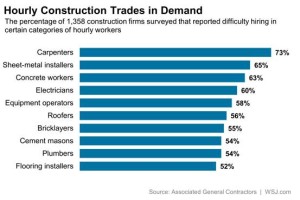The labor shortage is a common and growing concern in the construction industry, forcing many qualified contractors to turn down new projects and opportunities.
Let’s start with the good news: The United States housing market is showing signs of growth. Commercial spending is up 9.7% in the first half of 2015, and so far this year, housing starts have increased 11.3%. (source: Fortune.com, Sept. 2015) Now for the obvious and not so good news:The labor shortage is a common and consistent issue in the construction industry. In the news, we see it; as contractors, we live it. The need for skilled and professional talent is increasing, and many qualified contractors are being forced to turn down new projects due to the limited availability of trained and skilled construction workers.
The statistics and reports are seemingly published every day which certainly isn’t boosting morale in our industry. In an article by CNBC last month, it was noted that although contractors confirm a high demand in new construction, they are restricted by the lack of skilled workers. The article also highlighted the South as the most impacted area, as it experiences the most single-family home building in the nation. This week, the Wall Street Journal also reported on the issue, reviewing a survey conducted by the Associated General Contractors. In the article, it was noted that 86% of the construction firms surveyed claimed that they are struggling to find skilled workers from hourly “craft workers” to salaried specialists and supervisors.
The figures from this survey are consistent with the Associated General Contractors of America’s 2015 Construction Hiring and Business Outlook. In the 2015 Outlook, AGC projected a growing shortage in labor while compensation levels appeared to be increasing. Of the firms surveyed, 51% increased base pay of professionals and 46% increased compensation for skilled workers in order to retain their employees.
Various reports attempt to tackle the possible contributing factors to the shortage of skilled workers in construction. Rather than reviewing the potential causes, it is worth exploring some immediate and long-term solutions that may potentially alleviate some of the pressure contractors are facing on a day-to-day and job-to-job basis.
Increase Training – If you don’t have a regular and established training program in place, now is the perfect time to develop one. If you currently have a training program, now is the time to review, update and upgrade your training. Much like program development mentioned in a previous HBW post on safety, a technical training program would need to take your budget, time and resources into account prior to development. In-house training can be too costly for most small businesses and contractors, so consider hiring a third party and offering quarterly trainings, as well as on-the-job reviews and instruction. New hires should be welcomed with a strong onboarding process and technical training for those who need it. Your regional and national industry associations can be great sources for worker training videos and low-cost seminars and webinars.
Internships + Apprenticeships – From reaching out to upcoming graduates in trade schools to developing a comprehensive apprenticeship program, you could begin creating and nurturing your own talent pool. There are a number of outreach programs to engage the next generation and teach them about construction and requirements for a career in the industry. To provide opportunities to less experienced workers, you may develop an apprenticeship or internship program. You can refer to the Office of Apprenticeship (OA) in your state to ensure that your program meets mandatory requirements. The OA offers consultation and assistance in organization and management of such programs, and in some cases provides financing for registered apprenticeship programs. Here is a general guide to get you started:
- Determine if your company’s budget allows for an apprenticeship program.
- Create a detailed plan for the terms and conditions.
- Provide a minimum of 144 hours of technical instruction each year. You may choose to pair with a local vocational school.
- Create a schedule of wages for the apprentice, inclusive of incremental increases as new skills are mastered.
- Develop outcomes and measurements for the apprentice, with a plan for regular evaluation and reviews.
Review the U.S. Department of Labor Employment & Training Administration’s (DOLETA) Apprenticeship Program standards to determine whether your apprenticeship program qualifies as a registered apprenticeship program.
Retain Skilled Workers – With the increase in demand for skilled workers, you will need to make every effort to retain your current crews. This can be easier said than done. Beyond increasing compensation, you may want to offer more benefits or performance and project-based bonuses. There are plenty of unscrupulous recruiters and competitors who are looking for talent. Make sure you offer trainings, incentives and competitive wages. Communication is key, so make it a habit to check in with your team more than just for performance reviews. An “open door” policy and expressed appreciation can go a long way in building and retaining a high-quality team.
Subcontractors – Most contractors are more than familiar with subcontractors. Make sure you are building a long-lasting and successful relationship with qualified, licensed and insured subcontractors. Start out small and monitor their crews as well as see if your relationship can work in terms of contracts and payments. It is important to build a mutual trust and not rely on a random subcontractor because you simply must get a job done. To avoid the dreaded subcontractor defaults, create a payment plan that includes progress payments and retainage.
Plan Ahead – You can only take on as much work as you can complete within a realistic time frame. As tempting as it can be, don’t bite off more than you can chew. Nobody wants to turn down new projects and opportunities, but if you do not have the labor to meet the client’s expectations, it is not worth the great risk you put on the job and your reputation. Work with your customer to see if there is flexibility in the timeline and schedule jobs accordingly. You will need to spread out and be strategic with the projects you book. Don’t expend you labor on a small job with a limited profit margin when they could be more effective in a larger job on the horizon.
The current labor shortage is a harsh reality in the construction industry – one that won’t be improved overnight. Nonetheless, with more training, efforts for retaining talent and developing new talent there is great potential to benefit your business now, as well as add to a labor pool for the future of our industry.
HBW serves contractors and construction/design professionals in Alabama, Georgia, Texas, Florida, and Oklahoma. HBW offers the most current building trend and permitting activity reports, along with White Papers to assist in your marketing efforts. Contact us for a complimentary building data report or white paper today.


